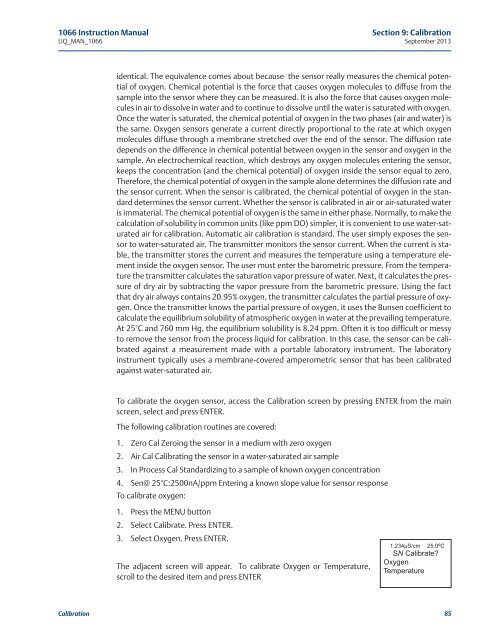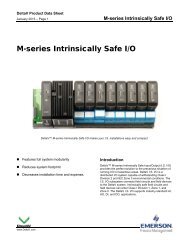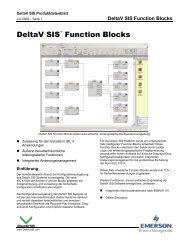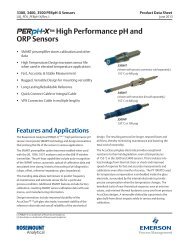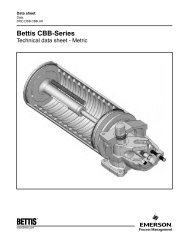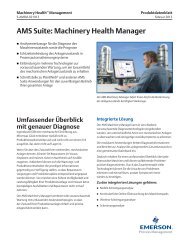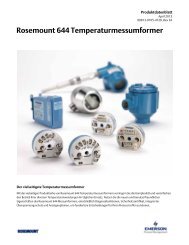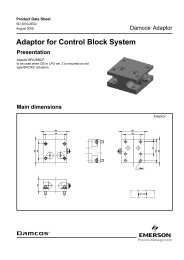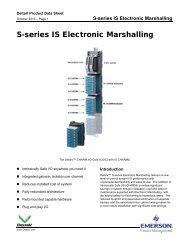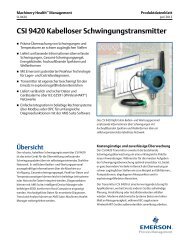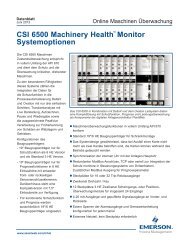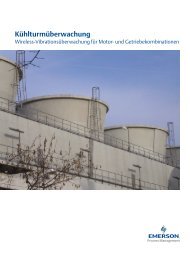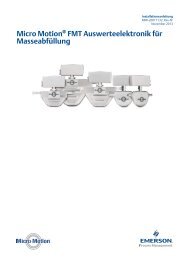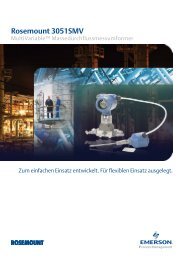1066 Liquid Analytical Transmitter - Emerson Process Management
1066 Liquid Analytical Transmitter - Emerson Process Management
1066 Liquid Analytical Transmitter - Emerson Process Management
You also want an ePaper? Increase the reach of your titles
YUMPU automatically turns print PDFs into web optimized ePapers that Google loves.
<strong>1066</strong> Instruction Manual Section 9: CalibrationLIQ_MAN_<strong>1066</strong> September 2013identical. The equivalence comes about because the sensor really measures the chemical potentialof oxygen. Chemical potential is the force that causes oxygen molecules to diffuse from thesample into the sensor where they can be measured. It is also the force that causes oxygen moleculesin air to dissolve in water and to continue to dissolve until the water is saturated with oxygen.Once the water is saturated, the chemical potential of oxygen in the two phases (air and water) isthe same. Oxygen sensors generate a current directly proportional to the rate at which oxygenmolecules diffuse through a membrane stretched over the end of the sensor. The diffusion ratedepends on the difference in chemical potential between oxygen in the sensor and oxygen in thesample. An electrochemical reaction, which destroys any oxygen molecules entering the sensor,keeps the concentration (and the chemical potential) of oxygen inside the sensor equal to zero.Therefore, the chemical potential of oxygen in the sample alone determines the diffusion rate andthe sensor current. When the sensor is calibrated, the chemical potential of oxygen in the standarddetermines the sensor current. Whether the sensor is calibrated in air or air-saturated wateris immaterial. The chemical potential of oxygen is the same in either phase. Normally, to make thecalculation of solubility in common units (like ppm DO) simpler, it is convenient to use water-saturatedair for calibration. Automatic air calibration is standard. The user simply exposes the sensorto water-saturated air. The transmitter monitors the sensor current. When the current is stable,the transmitter stores the current and measures the temperature using a temperature elementinside the oxygen sensor. The user must enter the barometric pressure. From the temperaturethe transmitter calculates the saturation vapor pressure of water. Next, it calculates the pressureof dry air by subtracting the vapor pressure from the barometric pressure. Using the factthat dry air always contains 20.95% oxygen, the transmitter calculates the partial pressure of oxygen.Once the transmitter knows the partial pressure of oxygen, it uses the Bunsen coefficient tocalculate the equilibrium solubility of atmospheric oxygen in water at the prevailing temperature.At 25°C and 760 mm Hg, the equilibrium solubility is 8.24 ppm. Often it is too difficult or messyto remove the sensor from the process liquid for calibration. In this case, the sensor can be calibratedagainst a measurement made with a portable laboratory instrument. The laboratoryinstrument typically uses a membrane-covered amperometric sensor that has been calibratedagainst water-saturated air.To calibrate the oxygen sensor, access the Calibration screen by pressing ENTER from the mainscreen, select and press ENTER.The following calibration routines are covered:1. Zero Cal Zeroing the sensor in a medium with zero oxygen2. Air Cal Calibrating the sensor in a water-saturated air sample3. In <strong>Process</strong> Cal Standardizing to a sample of known oxygen concentration4. Sen@ 25°C:2500nA/ppm Entering a known slope value for sensor responseTo calibrate oxygen:1. Press the MENU button2. Select Calibrate. Press ENTER.3. Select Oxygen. Press ENTER.The adjacent screen will appear. To calibrate Oxygen or Temperature,scroll to the desired item and press ENTER1.234µS/cm 25.0ºCSN Calibrate?OxygenTemperatureCalibration 85


